Healthcare Research Appraisal: Application of CASP Checklists
VerifiedAdded on 2023/06/11
|17
|4589
|335
Report
AI Summary
This assignment critically appraises healthcare research using CASP checklists, focusing on a qualitative study of aromatherapy for cancer patients and a randomized controlled trial on music's impact on anxiety and stress. The analysis assesses the validity, results, and applicability of both studies within the Chinese healthcare context. For the randomized controlled trial, the report examines aspects such as randomization, blinding, and treatment effects, determining the significance and precision of the results, and whether the outcomes can be applied to the local population and if all clinically relevant outcomes were considered. For the qualitative research, the report assesses the clarity of aims, appropriateness of methodology, and ethical considerations, ultimately evaluating the value and relevance of aromatherapy massage for cancer patients. The study also explores the cost-effectiveness and potential harms associated with implementing the findings. Desklib provides students with access to similar past papers and solved assignments.
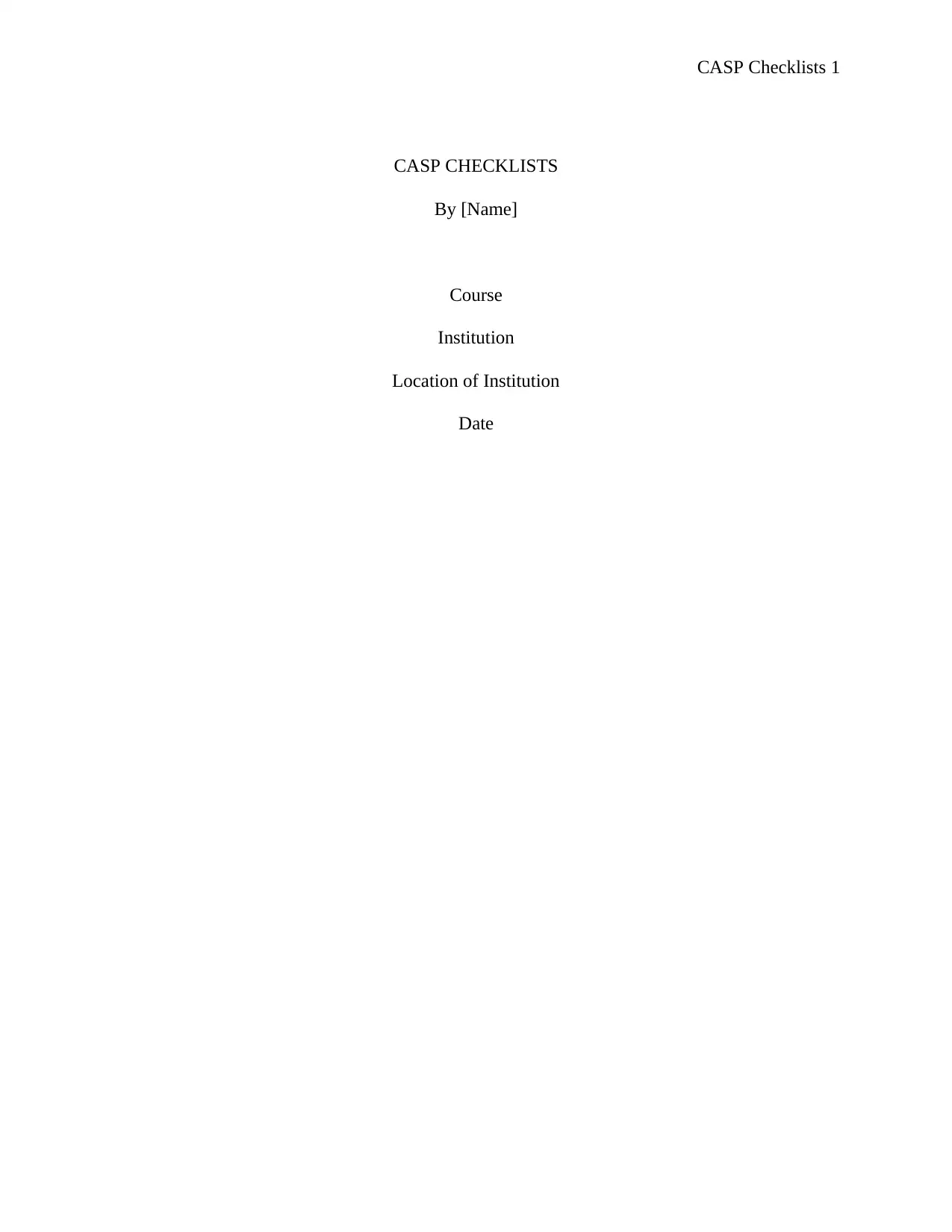
CASP Checklists 1
CASP CHECKLISTS
By [Name]
Course
Institution
Location of Institution
Date
CASP CHECKLISTS
By [Name]
Course
Institution
Location of Institution
Date
Secure Best Marks with AI Grader
Need help grading? Try our AI Grader for instant feedback on your assignments.
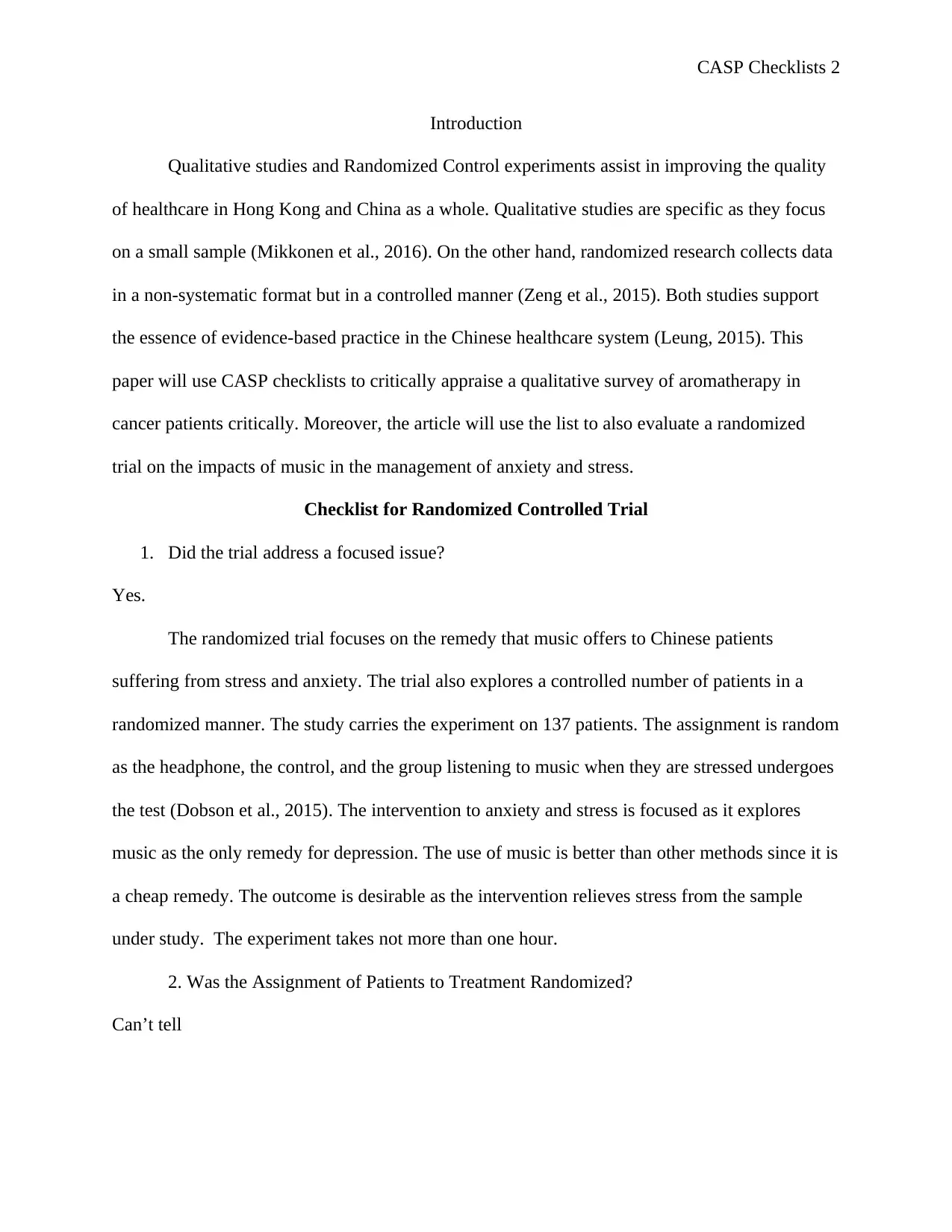
CASP Checklists 2
Introduction
Qualitative studies and Randomized Control experiments assist in improving the quality
of healthcare in Hong Kong and China as a whole. Qualitative studies are specific as they focus
on a small sample (Mikkonen et al., 2016). On the other hand, randomized research collects data
in a non-systematic format but in a controlled manner (Zeng et al., 2015). Both studies support
the essence of evidence-based practice in the Chinese healthcare system (Leung, 2015). This
paper will use CASP checklists to critically appraise a qualitative survey of aromatherapy in
cancer patients critically. Moreover, the article will use the list to also evaluate a randomized
trial on the impacts of music in the management of anxiety and stress.
Checklist for Randomized Controlled Trial
1. Did the trial address a focused issue?
Yes.
The randomized trial focuses on the remedy that music offers to Chinese patients
suffering from stress and anxiety. The trial also explores a controlled number of patients in a
randomized manner. The study carries the experiment on 137 patients. The assignment is random
as the headphone, the control, and the group listening to music when they are stressed undergoes
the test (Dobson et al., 2015). The intervention to anxiety and stress is focused as it explores
music as the only remedy for depression. The use of music is better than other methods since it is
a cheap remedy. The outcome is desirable as the intervention relieves stress from the sample
under study. The experiment takes not more than one hour.
2. Was the Assignment of Patients to Treatment Randomized?
Can’t tell
Introduction
Qualitative studies and Randomized Control experiments assist in improving the quality
of healthcare in Hong Kong and China as a whole. Qualitative studies are specific as they focus
on a small sample (Mikkonen et al., 2016). On the other hand, randomized research collects data
in a non-systematic format but in a controlled manner (Zeng et al., 2015). Both studies support
the essence of evidence-based practice in the Chinese healthcare system (Leung, 2015). This
paper will use CASP checklists to critically appraise a qualitative survey of aromatherapy in
cancer patients critically. Moreover, the article will use the list to also evaluate a randomized
trial on the impacts of music in the management of anxiety and stress.
Checklist for Randomized Controlled Trial
1. Did the trial address a focused issue?
Yes.
The randomized trial focuses on the remedy that music offers to Chinese patients
suffering from stress and anxiety. The trial also explores a controlled number of patients in a
randomized manner. The study carries the experiment on 137 patients. The assignment is random
as the headphone, the control, and the group listening to music when they are stressed undergoes
the test (Dobson et al., 2015). The intervention to anxiety and stress is focused as it explores
music as the only remedy for depression. The use of music is better than other methods since it is
a cheap remedy. The outcome is desirable as the intervention relieves stress from the sample
under study. The experiment takes not more than one hour.
2. Was the Assignment of Patients to Treatment Randomized?
Can’t tell
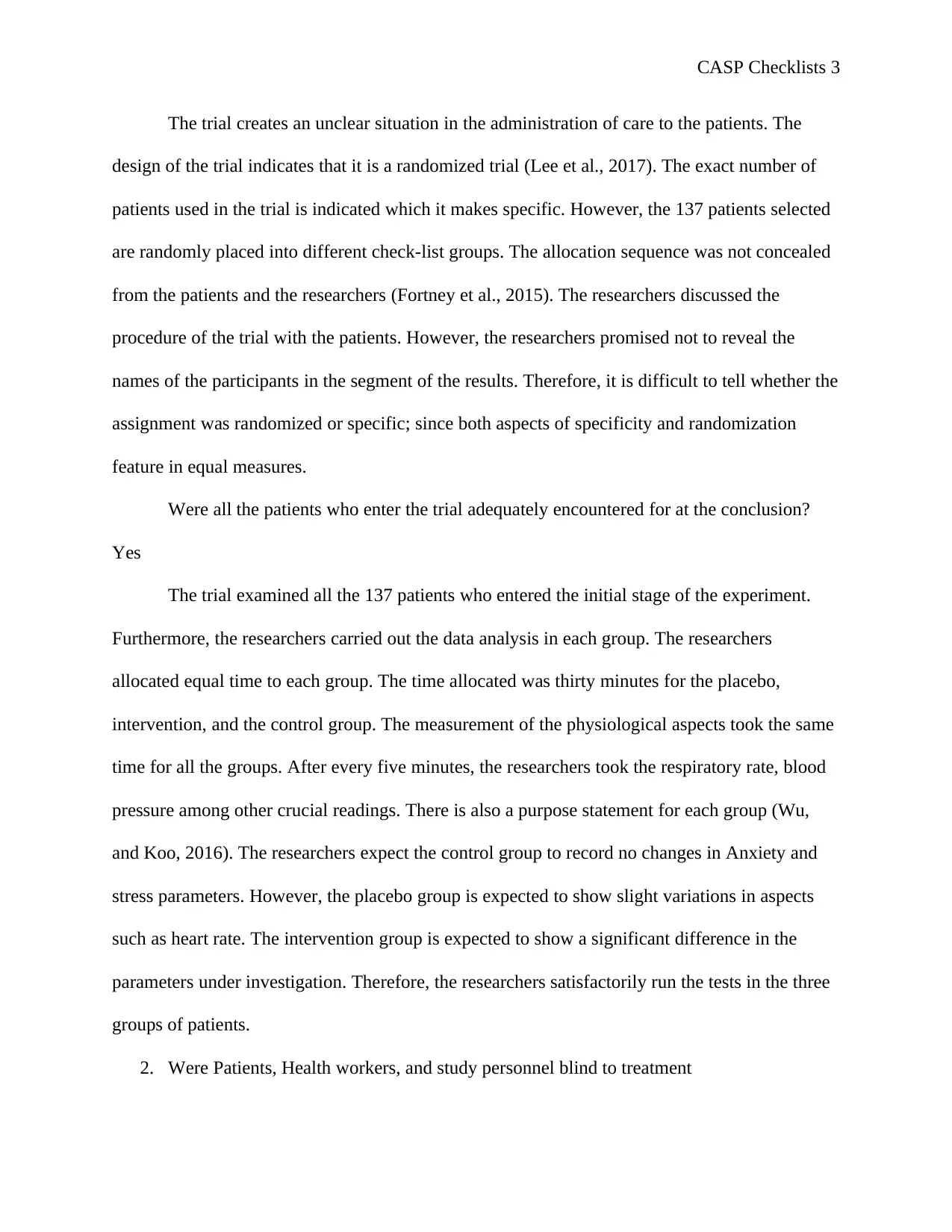
CASP Checklists 3
The trial creates an unclear situation in the administration of care to the patients. The
design of the trial indicates that it is a randomized trial (Lee et al., 2017). The exact number of
patients used in the trial is indicated which it makes specific. However, the 137 patients selected
are randomly placed into different check-list groups. The allocation sequence was not concealed
from the patients and the researchers (Fortney et al., 2015). The researchers discussed the
procedure of the trial with the patients. However, the researchers promised not to reveal the
names of the participants in the segment of the results. Therefore, it is difficult to tell whether the
assignment was randomized or specific; since both aspects of specificity and randomization
feature in equal measures.
Were all the patients who enter the trial adequately encountered for at the conclusion?
Yes
The trial examined all the 137 patients who entered the initial stage of the experiment.
Furthermore, the researchers carried out the data analysis in each group. The researchers
allocated equal time to each group. The time allocated was thirty minutes for the placebo,
intervention, and the control group. The measurement of the physiological aspects took the same
time for all the groups. After every five minutes, the researchers took the respiratory rate, blood
pressure among other crucial readings. There is also a purpose statement for each group (Wu,
and Koo, 2016). The researchers expect the control group to record no changes in Anxiety and
stress parameters. However, the placebo group is expected to show slight variations in aspects
such as heart rate. The intervention group is expected to show a significant difference in the
parameters under investigation. Therefore, the researchers satisfactorily run the tests in the three
groups of patients.
2. Were Patients, Health workers, and study personnel blind to treatment
The trial creates an unclear situation in the administration of care to the patients. The
design of the trial indicates that it is a randomized trial (Lee et al., 2017). The exact number of
patients used in the trial is indicated which it makes specific. However, the 137 patients selected
are randomly placed into different check-list groups. The allocation sequence was not concealed
from the patients and the researchers (Fortney et al., 2015). The researchers discussed the
procedure of the trial with the patients. However, the researchers promised not to reveal the
names of the participants in the segment of the results. Therefore, it is difficult to tell whether the
assignment was randomized or specific; since both aspects of specificity and randomization
feature in equal measures.
Were all the patients who enter the trial adequately encountered for at the conclusion?
Yes
The trial examined all the 137 patients who entered the initial stage of the experiment.
Furthermore, the researchers carried out the data analysis in each group. The researchers
allocated equal time to each group. The time allocated was thirty minutes for the placebo,
intervention, and the control group. The measurement of the physiological aspects took the same
time for all the groups. After every five minutes, the researchers took the respiratory rate, blood
pressure among other crucial readings. There is also a purpose statement for each group (Wu,
and Koo, 2016). The researchers expect the control group to record no changes in Anxiety and
stress parameters. However, the placebo group is expected to show slight variations in aspects
such as heart rate. The intervention group is expected to show a significant difference in the
parameters under investigation. Therefore, the researchers satisfactorily run the tests in the three
groups of patients.
2. Were Patients, Health workers, and study personnel blind to treatment
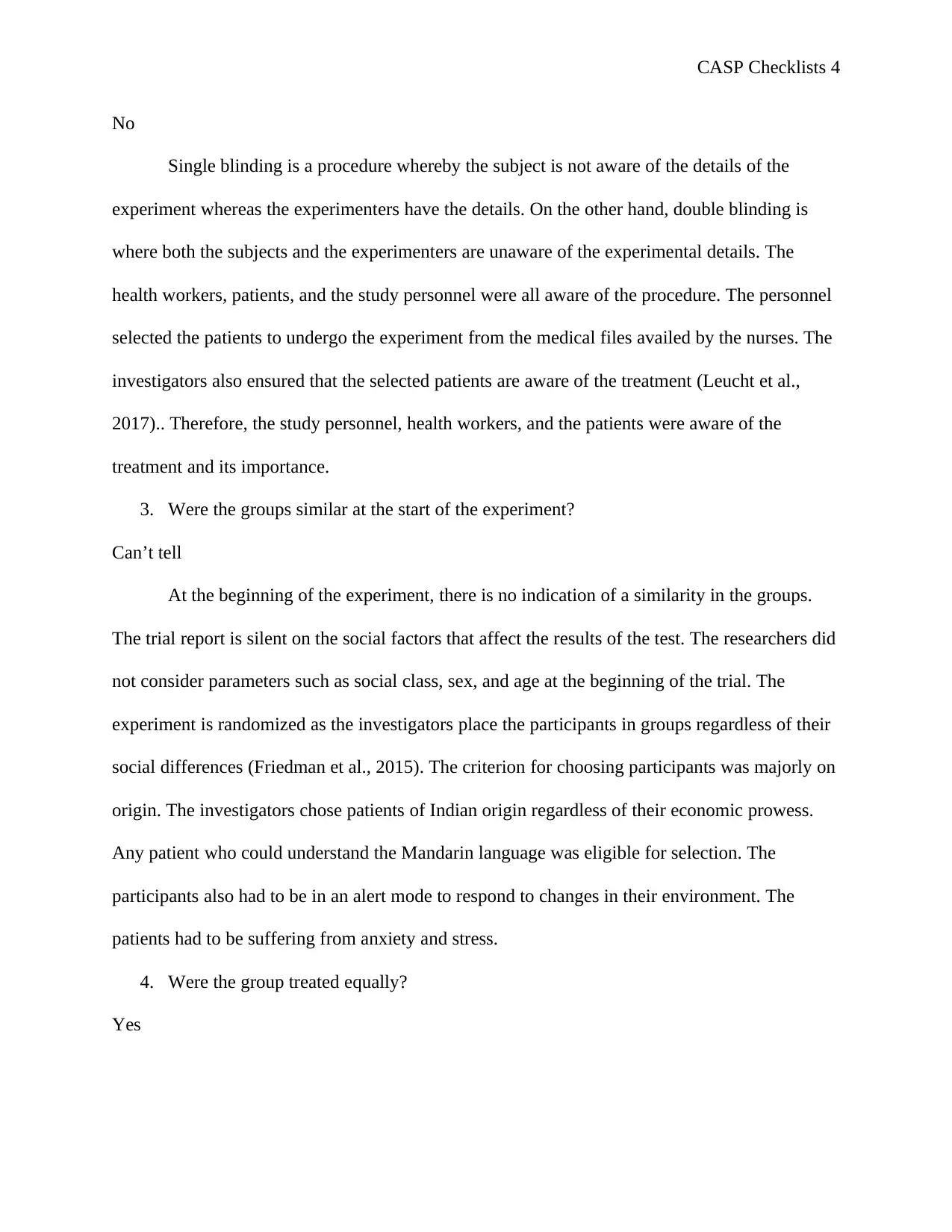
CASP Checklists 4
No
Single blinding is a procedure whereby the subject is not aware of the details of the
experiment whereas the experimenters have the details. On the other hand, double blinding is
where both the subjects and the experimenters are unaware of the experimental details. The
health workers, patients, and the study personnel were all aware of the procedure. The personnel
selected the patients to undergo the experiment from the medical files availed by the nurses. The
investigators also ensured that the selected patients are aware of the treatment (Leucht et al.,
2017).. Therefore, the study personnel, health workers, and the patients were aware of the
treatment and its importance.
3. Were the groups similar at the start of the experiment?
Can’t tell
At the beginning of the experiment, there is no indication of a similarity in the groups.
The trial report is silent on the social factors that affect the results of the test. The researchers did
not consider parameters such as social class, sex, and age at the beginning of the trial. The
experiment is randomized as the investigators place the participants in groups regardless of their
social differences (Friedman et al., 2015). The criterion for choosing participants was majorly on
origin. The investigators chose patients of Indian origin regardless of their economic prowess.
Any patient who could understand the Mandarin language was eligible for selection. The
participants also had to be in an alert mode to respond to changes in their environment. The
patients had to be suffering from anxiety and stress.
4. Were the group treated equally?
Yes
No
Single blinding is a procedure whereby the subject is not aware of the details of the
experiment whereas the experimenters have the details. On the other hand, double blinding is
where both the subjects and the experimenters are unaware of the experimental details. The
health workers, patients, and the study personnel were all aware of the procedure. The personnel
selected the patients to undergo the experiment from the medical files availed by the nurses. The
investigators also ensured that the selected patients are aware of the treatment (Leucht et al.,
2017).. Therefore, the study personnel, health workers, and the patients were aware of the
treatment and its importance.
3. Were the groups similar at the start of the experiment?
Can’t tell
At the beginning of the experiment, there is no indication of a similarity in the groups.
The trial report is silent on the social factors that affect the results of the test. The researchers did
not consider parameters such as social class, sex, and age at the beginning of the trial. The
experiment is randomized as the investigators place the participants in groups regardless of their
social differences (Friedman et al., 2015). The criterion for choosing participants was majorly on
origin. The investigators chose patients of Indian origin regardless of their economic prowess.
Any patient who could understand the Mandarin language was eligible for selection. The
participants also had to be in an alert mode to respond to changes in their environment. The
patients had to be suffering from anxiety and stress.
4. Were the group treated equally?
Yes
Secure Best Marks with AI Grader
Need help grading? Try our AI Grader for instant feedback on your assignments.
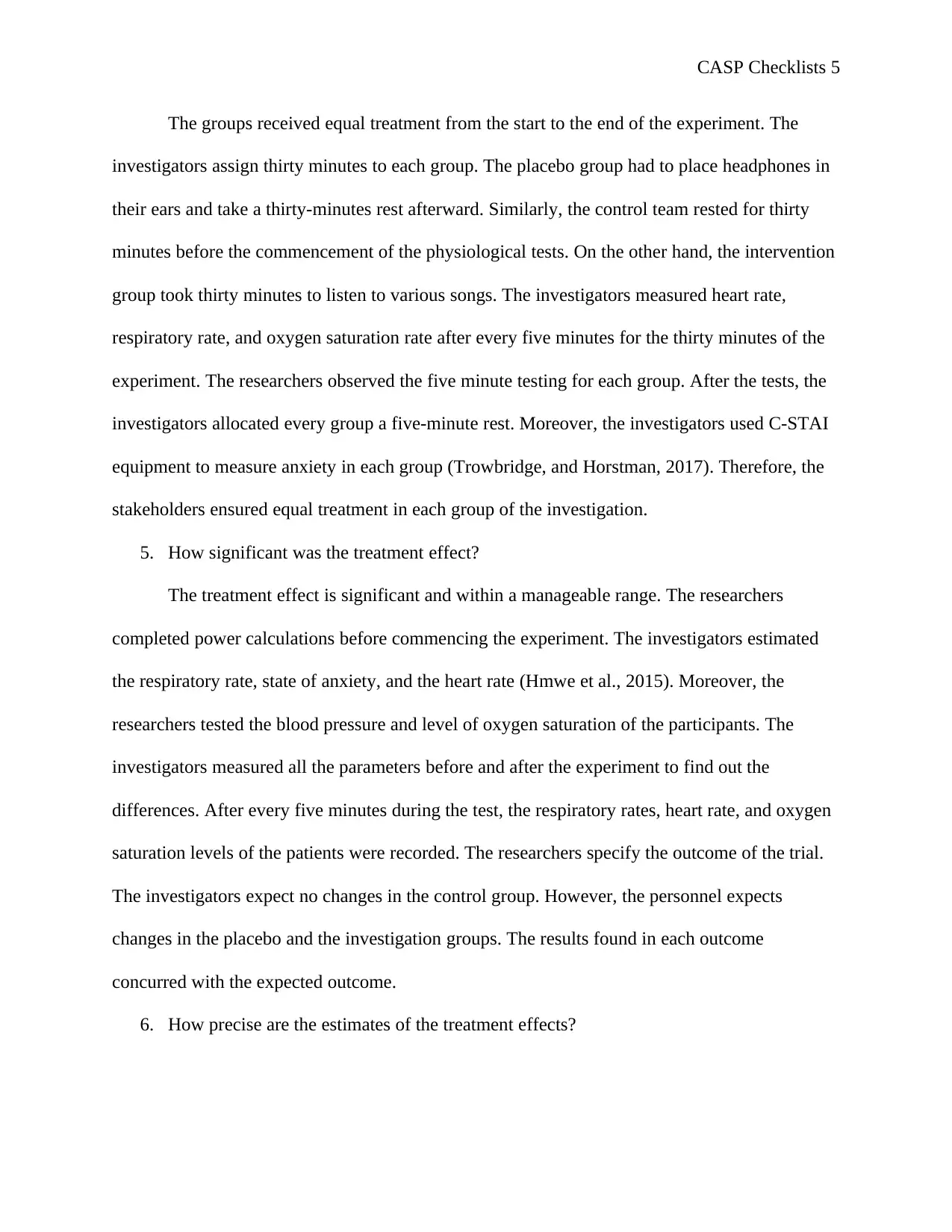
CASP Checklists 5
The groups received equal treatment from the start to the end of the experiment. The
investigators assign thirty minutes to each group. The placebo group had to place headphones in
their ears and take a thirty-minutes rest afterward. Similarly, the control team rested for thirty
minutes before the commencement of the physiological tests. On the other hand, the intervention
group took thirty minutes to listen to various songs. The investigators measured heart rate,
respiratory rate, and oxygen saturation rate after every five minutes for the thirty minutes of the
experiment. The researchers observed the five minute testing for each group. After the tests, the
investigators allocated every group a five-minute rest. Moreover, the investigators used C-STAI
equipment to measure anxiety in each group (Trowbridge, and Horstman, 2017). Therefore, the
stakeholders ensured equal treatment in each group of the investigation.
5. How significant was the treatment effect?
The treatment effect is significant and within a manageable range. The researchers
completed power calculations before commencing the experiment. The investigators estimated
the respiratory rate, state of anxiety, and the heart rate (Hmwe et al., 2015). Moreover, the
researchers tested the blood pressure and level of oxygen saturation of the participants. The
investigators measured all the parameters before and after the experiment to find out the
differences. After every five minutes during the test, the respiratory rates, heart rate, and oxygen
saturation levels of the patients were recorded. The researchers specify the outcome of the trial.
The investigators expect no changes in the control group. However, the personnel expects
changes in the placebo and the investigation groups. The results found in each outcome
concurred with the expected outcome.
6. How precise are the estimates of the treatment effects?
The groups received equal treatment from the start to the end of the experiment. The
investigators assign thirty minutes to each group. The placebo group had to place headphones in
their ears and take a thirty-minutes rest afterward. Similarly, the control team rested for thirty
minutes before the commencement of the physiological tests. On the other hand, the intervention
group took thirty minutes to listen to various songs. The investigators measured heart rate,
respiratory rate, and oxygen saturation rate after every five minutes for the thirty minutes of the
experiment. The researchers observed the five minute testing for each group. After the tests, the
investigators allocated every group a five-minute rest. Moreover, the investigators used C-STAI
equipment to measure anxiety in each group (Trowbridge, and Horstman, 2017). Therefore, the
stakeholders ensured equal treatment in each group of the investigation.
5. How significant was the treatment effect?
The treatment effect is significant and within a manageable range. The researchers
completed power calculations before commencing the experiment. The investigators estimated
the respiratory rate, state of anxiety, and the heart rate (Hmwe et al., 2015). Moreover, the
researchers tested the blood pressure and level of oxygen saturation of the participants. The
investigators measured all the parameters before and after the experiment to find out the
differences. After every five minutes during the test, the respiratory rates, heart rate, and oxygen
saturation levels of the patients were recorded. The researchers specify the outcome of the trial.
The investigators expect no changes in the control group. However, the personnel expects
changes in the placebo and the investigation groups. The results found in each outcome
concurred with the expected outcome.
6. How precise are the estimates of the treatment effects?
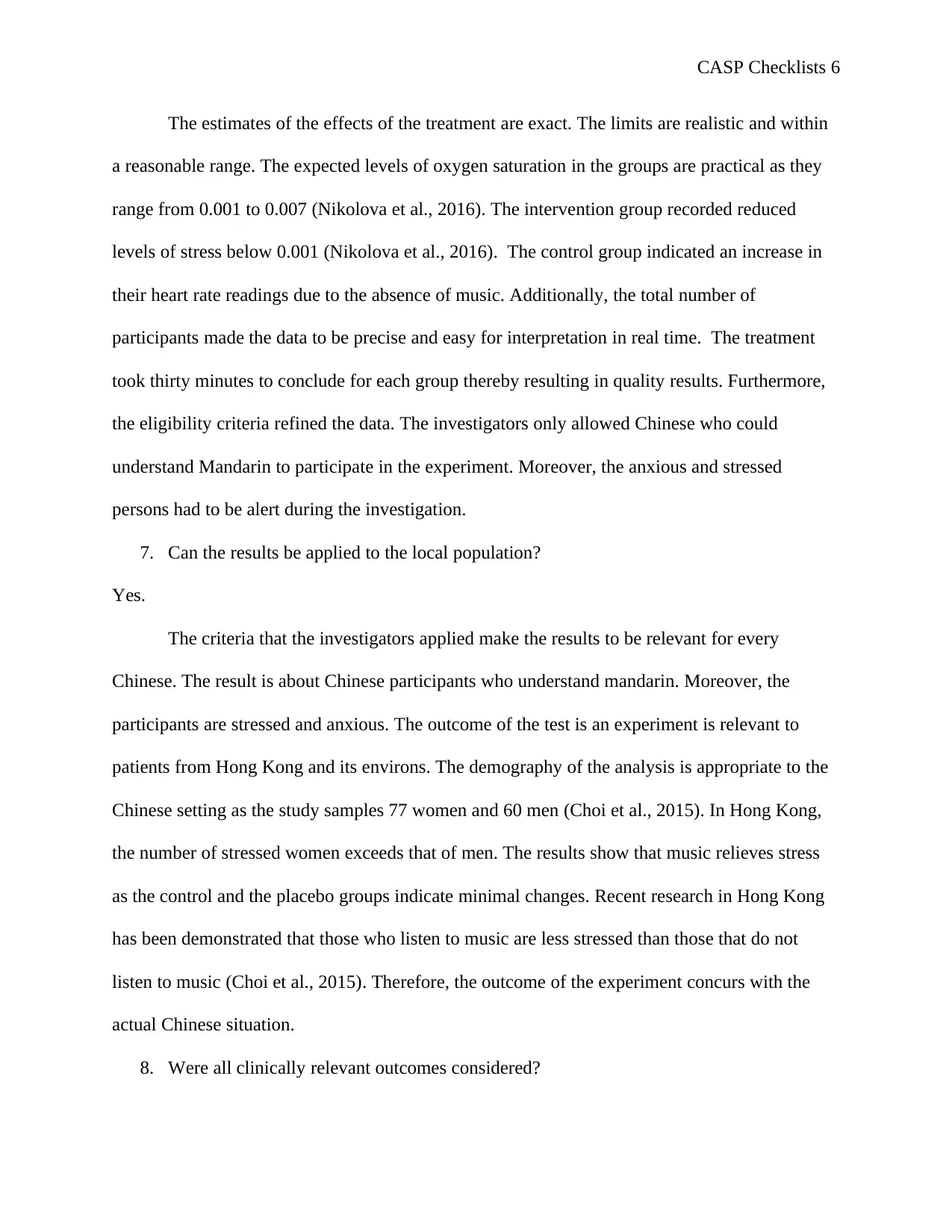
CASP Checklists 6
The estimates of the effects of the treatment are exact. The limits are realistic and within
a reasonable range. The expected levels of oxygen saturation in the groups are practical as they
range from 0.001 to 0.007 (Nikolova et al., 2016). The intervention group recorded reduced
levels of stress below 0.001 (Nikolova et al., 2016). The control group indicated an increase in
their heart rate readings due to the absence of music. Additionally, the total number of
participants made the data to be precise and easy for interpretation in real time. The treatment
took thirty minutes to conclude for each group thereby resulting in quality results. Furthermore,
the eligibility criteria refined the data. The investigators only allowed Chinese who could
understand Mandarin to participate in the experiment. Moreover, the anxious and stressed
persons had to be alert during the investigation.
7. Can the results be applied to the local population?
Yes.
The criteria that the investigators applied make the results to be relevant for every
Chinese. The result is about Chinese participants who understand mandarin. Moreover, the
participants are stressed and anxious. The outcome of the test is an experiment is relevant to
patients from Hong Kong and its environs. The demography of the analysis is appropriate to the
Chinese setting as the study samples 77 women and 60 men (Choi et al., 2015). In Hong Kong,
the number of stressed women exceeds that of men. The results show that music relieves stress
as the control and the placebo groups indicate minimal changes. Recent research in Hong Kong
has been demonstrated that those who listen to music are less stressed than those that do not
listen to music (Choi et al., 2015). Therefore, the outcome of the experiment concurs with the
actual Chinese situation.
8. Were all clinically relevant outcomes considered?
The estimates of the effects of the treatment are exact. The limits are realistic and within
a reasonable range. The expected levels of oxygen saturation in the groups are practical as they
range from 0.001 to 0.007 (Nikolova et al., 2016). The intervention group recorded reduced
levels of stress below 0.001 (Nikolova et al., 2016). The control group indicated an increase in
their heart rate readings due to the absence of music. Additionally, the total number of
participants made the data to be precise and easy for interpretation in real time. The treatment
took thirty minutes to conclude for each group thereby resulting in quality results. Furthermore,
the eligibility criteria refined the data. The investigators only allowed Chinese who could
understand Mandarin to participate in the experiment. Moreover, the anxious and stressed
persons had to be alert during the investigation.
7. Can the results be applied to the local population?
Yes.
The criteria that the investigators applied make the results to be relevant for every
Chinese. The result is about Chinese participants who understand mandarin. Moreover, the
participants are stressed and anxious. The outcome of the test is an experiment is relevant to
patients from Hong Kong and its environs. The demography of the analysis is appropriate to the
Chinese setting as the study samples 77 women and 60 men (Choi et al., 2015). In Hong Kong,
the number of stressed women exceeds that of men. The results show that music relieves stress
as the control and the placebo groups indicate minimal changes. Recent research in Hong Kong
has been demonstrated that those who listen to music are less stressed than those that do not
listen to music (Choi et al., 2015). Therefore, the outcome of the experiment concurs with the
actual Chinese situation.
8. Were all clinically relevant outcomes considered?
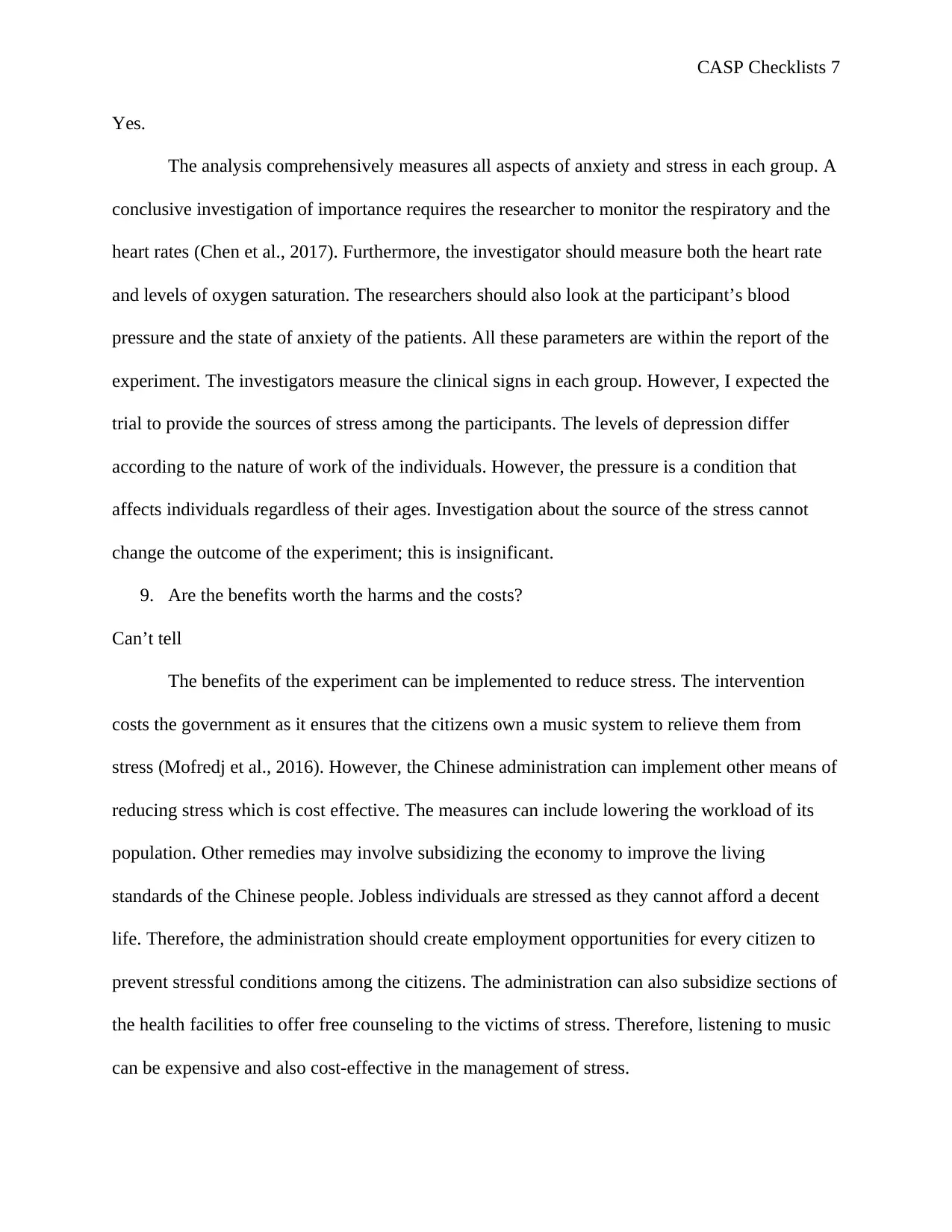
CASP Checklists 7
Yes.
The analysis comprehensively measures all aspects of anxiety and stress in each group. A
conclusive investigation of importance requires the researcher to monitor the respiratory and the
heart rates (Chen et al., 2017). Furthermore, the investigator should measure both the heart rate
and levels of oxygen saturation. The researchers should also look at the participant’s blood
pressure and the state of anxiety of the patients. All these parameters are within the report of the
experiment. The investigators measure the clinical signs in each group. However, I expected the
trial to provide the sources of stress among the participants. The levels of depression differ
according to the nature of work of the individuals. However, the pressure is a condition that
affects individuals regardless of their ages. Investigation about the source of the stress cannot
change the outcome of the experiment; this is insignificant.
9. Are the benefits worth the harms and the costs?
Can’t tell
The benefits of the experiment can be implemented to reduce stress. The intervention
costs the government as it ensures that the citizens own a music system to relieve them from
stress (Mofredj et al., 2016). However, the Chinese administration can implement other means of
reducing stress which is cost effective. The measures can include lowering the workload of its
population. Other remedies may involve subsidizing the economy to improve the living
standards of the Chinese people. Jobless individuals are stressed as they cannot afford a decent
life. Therefore, the administration should create employment opportunities for every citizen to
prevent stressful conditions among the citizens. The administration can also subsidize sections of
the health facilities to offer free counseling to the victims of stress. Therefore, listening to music
can be expensive and also cost-effective in the management of stress.
Yes.
The analysis comprehensively measures all aspects of anxiety and stress in each group. A
conclusive investigation of importance requires the researcher to monitor the respiratory and the
heart rates (Chen et al., 2017). Furthermore, the investigator should measure both the heart rate
and levels of oxygen saturation. The researchers should also look at the participant’s blood
pressure and the state of anxiety of the patients. All these parameters are within the report of the
experiment. The investigators measure the clinical signs in each group. However, I expected the
trial to provide the sources of stress among the participants. The levels of depression differ
according to the nature of work of the individuals. However, the pressure is a condition that
affects individuals regardless of their ages. Investigation about the source of the stress cannot
change the outcome of the experiment; this is insignificant.
9. Are the benefits worth the harms and the costs?
Can’t tell
The benefits of the experiment can be implemented to reduce stress. The intervention
costs the government as it ensures that the citizens own a music system to relieve them from
stress (Mofredj et al., 2016). However, the Chinese administration can implement other means of
reducing stress which is cost effective. The measures can include lowering the workload of its
population. Other remedies may involve subsidizing the economy to improve the living
standards of the Chinese people. Jobless individuals are stressed as they cannot afford a decent
life. Therefore, the administration should create employment opportunities for every citizen to
prevent stressful conditions among the citizens. The administration can also subsidize sections of
the health facilities to offer free counseling to the victims of stress. Therefore, listening to music
can be expensive and also cost-effective in the management of stress.
Paraphrase This Document
Need a fresh take? Get an instant paraphrase of this document with our AI Paraphraser
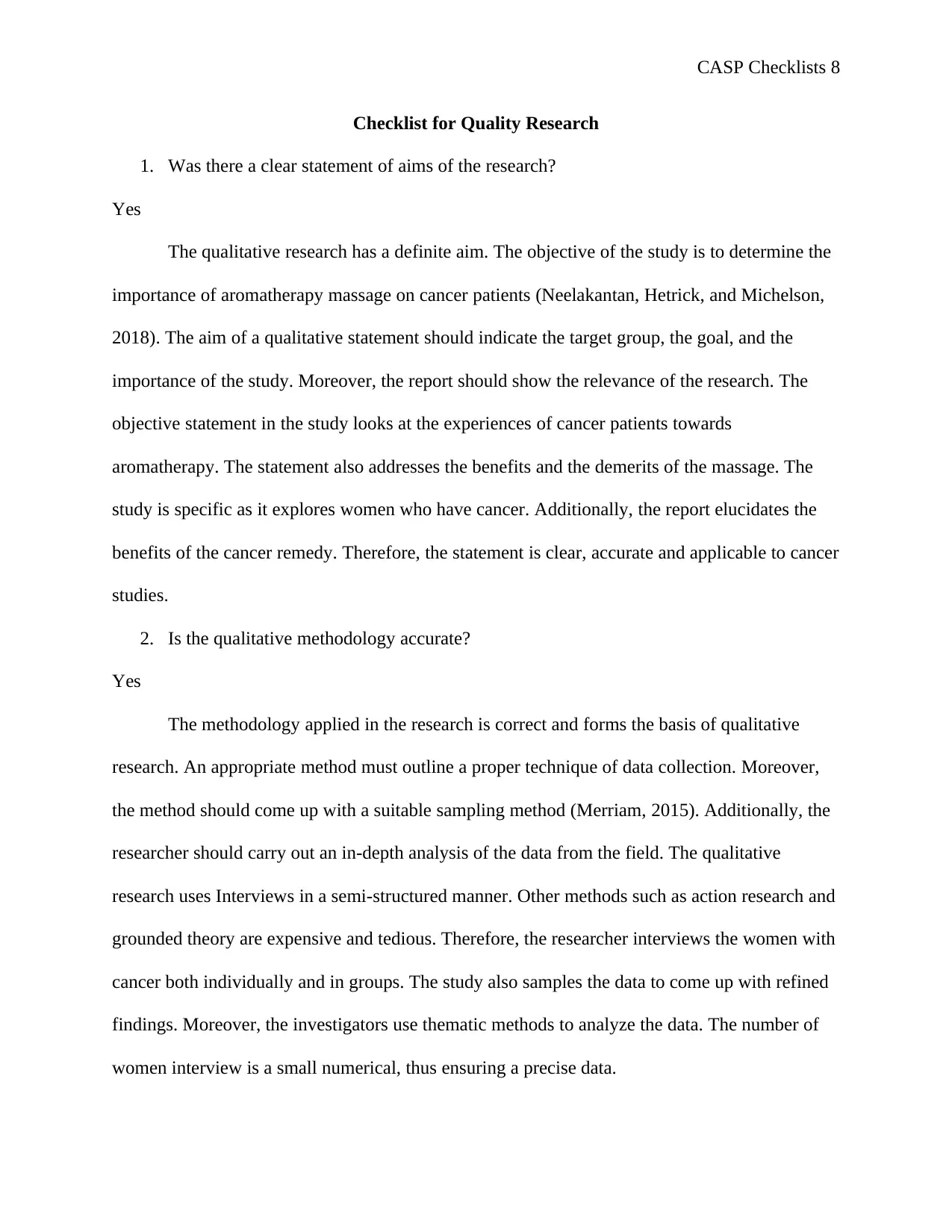
CASP Checklists 8
Checklist for Quality Research
1. Was there a clear statement of aims of the research?
Yes
The qualitative research has a definite aim. The objective of the study is to determine the
importance of aromatherapy massage on cancer patients (Neelakantan, Hetrick, and Michelson,
2018). The aim of a qualitative statement should indicate the target group, the goal, and the
importance of the study. Moreover, the report should show the relevance of the research. The
objective statement in the study looks at the experiences of cancer patients towards
aromatherapy. The statement also addresses the benefits and the demerits of the massage. The
study is specific as it explores women who have cancer. Additionally, the report elucidates the
benefits of the cancer remedy. Therefore, the statement is clear, accurate and applicable to cancer
studies.
2. Is the qualitative methodology accurate?
Yes
The methodology applied in the research is correct and forms the basis of qualitative
research. An appropriate method must outline a proper technique of data collection. Moreover,
the method should come up with a suitable sampling method (Merriam, 2015). Additionally, the
researcher should carry out an in-depth analysis of the data from the field. The qualitative
research uses Interviews in a semi-structured manner. Other methods such as action research and
grounded theory are expensive and tedious. Therefore, the researcher interviews the women with
cancer both individually and in groups. The study also samples the data to come up with refined
findings. Moreover, the investigators use thematic methods to analyze the data. The number of
women interview is a small numerical, thus ensuring a precise data.
Checklist for Quality Research
1. Was there a clear statement of aims of the research?
Yes
The qualitative research has a definite aim. The objective of the study is to determine the
importance of aromatherapy massage on cancer patients (Neelakantan, Hetrick, and Michelson,
2018). The aim of a qualitative statement should indicate the target group, the goal, and the
importance of the study. Moreover, the report should show the relevance of the research. The
objective statement in the study looks at the experiences of cancer patients towards
aromatherapy. The statement also addresses the benefits and the demerits of the massage. The
study is specific as it explores women who have cancer. Additionally, the report elucidates the
benefits of the cancer remedy. Therefore, the statement is clear, accurate and applicable to cancer
studies.
2. Is the qualitative methodology accurate?
Yes
The methodology applied in the research is correct and forms the basis of qualitative
research. An appropriate method must outline a proper technique of data collection. Moreover,
the method should come up with a suitable sampling method (Merriam, 2015). Additionally, the
researcher should carry out an in-depth analysis of the data from the field. The qualitative
research uses Interviews in a semi-structured manner. Other methods such as action research and
grounded theory are expensive and tedious. Therefore, the researcher interviews the women with
cancer both individually and in groups. The study also samples the data to come up with refined
findings. Moreover, the investigators use thematic methods to analyze the data. The number of
women interview is a small numerical, thus ensuring a precise data.
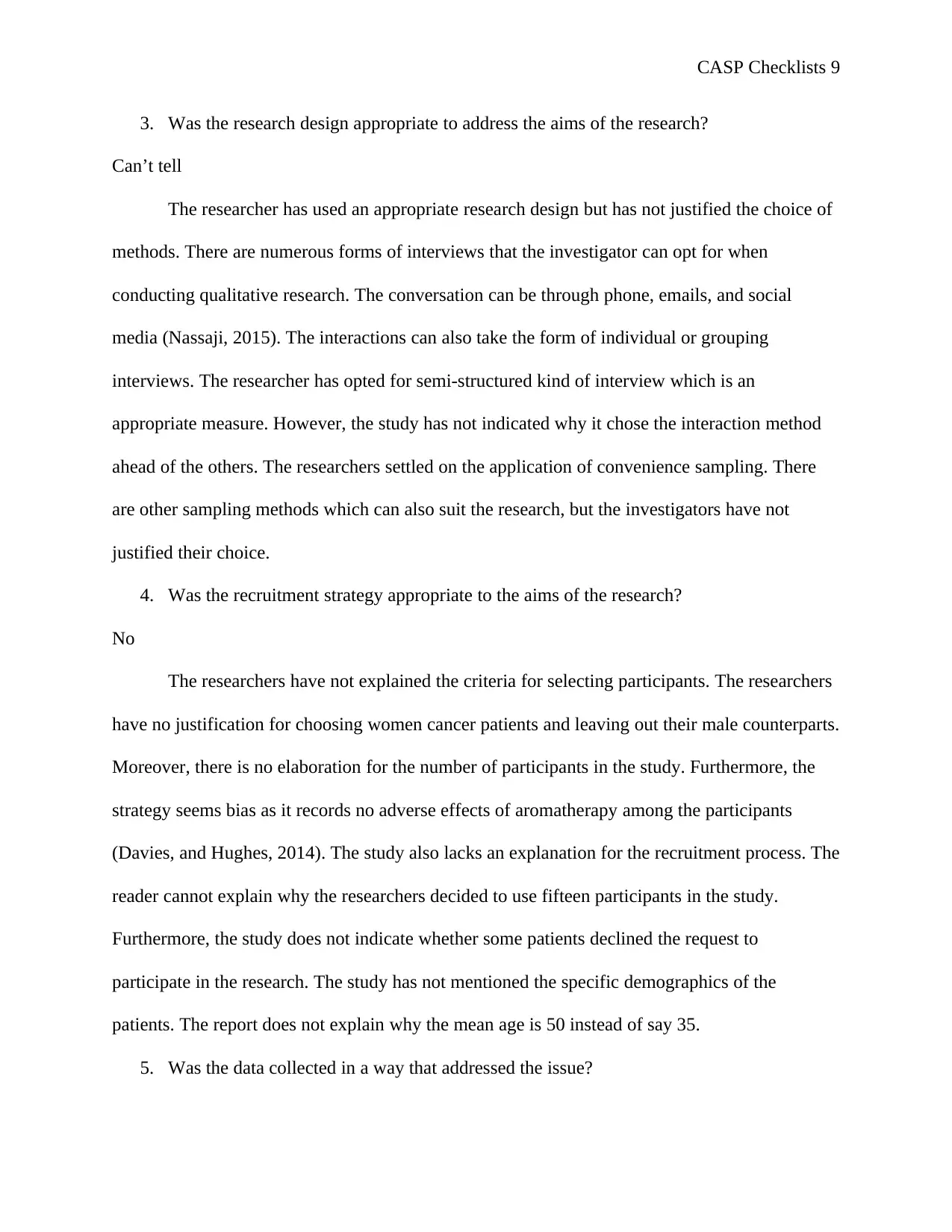
CASP Checklists 9
3. Was the research design appropriate to address the aims of the research?
Can’t tell
The researcher has used an appropriate research design but has not justified the choice of
methods. There are numerous forms of interviews that the investigator can opt for when
conducting qualitative research. The conversation can be through phone, emails, and social
media (Nassaji, 2015). The interactions can also take the form of individual or grouping
interviews. The researcher has opted for semi-structured kind of interview which is an
appropriate measure. However, the study has not indicated why it chose the interaction method
ahead of the others. The researchers settled on the application of convenience sampling. There
are other sampling methods which can also suit the research, but the investigators have not
justified their choice.
4. Was the recruitment strategy appropriate to the aims of the research?
No
The researchers have not explained the criteria for selecting participants. The researchers
have no justification for choosing women cancer patients and leaving out their male counterparts.
Moreover, there is no elaboration for the number of participants in the study. Furthermore, the
strategy seems bias as it records no adverse effects of aromatherapy among the participants
(Davies, and Hughes, 2014). The study also lacks an explanation for the recruitment process. The
reader cannot explain why the researchers decided to use fifteen participants in the study.
Furthermore, the study does not indicate whether some patients declined the request to
participate in the research. The study has not mentioned the specific demographics of the
patients. The report does not explain why the mean age is 50 instead of say 35.
5. Was the data collected in a way that addressed the issue?
3. Was the research design appropriate to address the aims of the research?
Can’t tell
The researcher has used an appropriate research design but has not justified the choice of
methods. There are numerous forms of interviews that the investigator can opt for when
conducting qualitative research. The conversation can be through phone, emails, and social
media (Nassaji, 2015). The interactions can also take the form of individual or grouping
interviews. The researcher has opted for semi-structured kind of interview which is an
appropriate measure. However, the study has not indicated why it chose the interaction method
ahead of the others. The researchers settled on the application of convenience sampling. There
are other sampling methods which can also suit the research, but the investigators have not
justified their choice.
4. Was the recruitment strategy appropriate to the aims of the research?
No
The researchers have not explained the criteria for selecting participants. The researchers
have no justification for choosing women cancer patients and leaving out their male counterparts.
Moreover, there is no elaboration for the number of participants in the study. Furthermore, the
strategy seems bias as it records no adverse effects of aromatherapy among the participants
(Davies, and Hughes, 2014). The study also lacks an explanation for the recruitment process. The
reader cannot explain why the researchers decided to use fifteen participants in the study.
Furthermore, the study does not indicate whether some patients declined the request to
participate in the research. The study has not mentioned the specific demographics of the
patients. The report does not explain why the mean age is 50 instead of say 35.
5. Was the data collected in a way that addressed the issue?
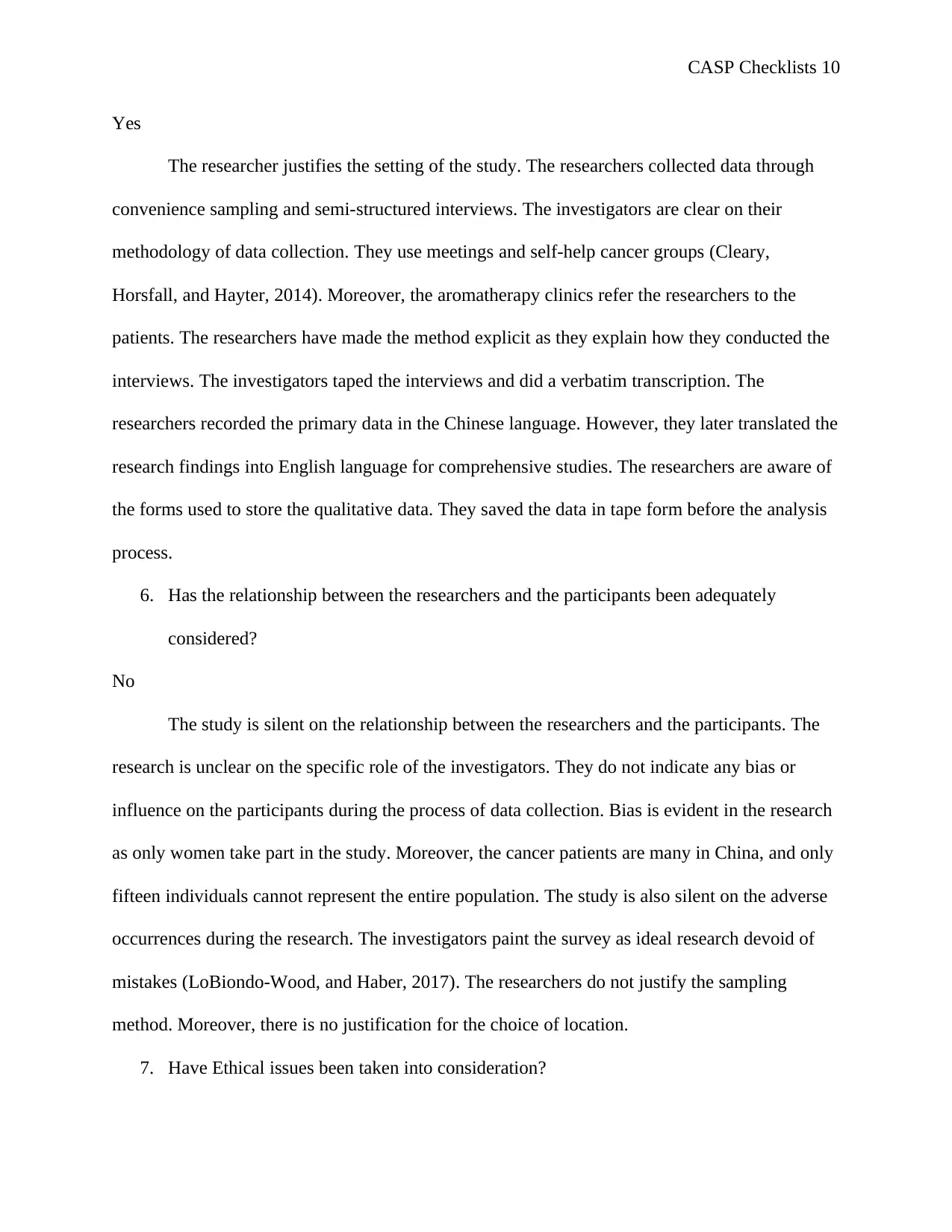
CASP Checklists 10
Yes
The researcher justifies the setting of the study. The researchers collected data through
convenience sampling and semi-structured interviews. The investigators are clear on their
methodology of data collection. They use meetings and self-help cancer groups (Cleary,
Horsfall, and Hayter, 2014). Moreover, the aromatherapy clinics refer the researchers to the
patients. The researchers have made the method explicit as they explain how they conducted the
interviews. The investigators taped the interviews and did a verbatim transcription. The
researchers recorded the primary data in the Chinese language. However, they later translated the
research findings into English language for comprehensive studies. The researchers are aware of
the forms used to store the qualitative data. They saved the data in tape form before the analysis
process.
6. Has the relationship between the researchers and the participants been adequately
considered?
No
The study is silent on the relationship between the researchers and the participants. The
research is unclear on the specific role of the investigators. They do not indicate any bias or
influence on the participants during the process of data collection. Bias is evident in the research
as only women take part in the study. Moreover, the cancer patients are many in China, and only
fifteen individuals cannot represent the entire population. The study is also silent on the adverse
occurrences during the research. The investigators paint the survey as ideal research devoid of
mistakes (LoBiondo-Wood, and Haber, 2017). The researchers do not justify the sampling
method. Moreover, there is no justification for the choice of location.
7. Have Ethical issues been taken into consideration?
Yes
The researcher justifies the setting of the study. The researchers collected data through
convenience sampling and semi-structured interviews. The investigators are clear on their
methodology of data collection. They use meetings and self-help cancer groups (Cleary,
Horsfall, and Hayter, 2014). Moreover, the aromatherapy clinics refer the researchers to the
patients. The researchers have made the method explicit as they explain how they conducted the
interviews. The investigators taped the interviews and did a verbatim transcription. The
researchers recorded the primary data in the Chinese language. However, they later translated the
research findings into English language for comprehensive studies. The researchers are aware of
the forms used to store the qualitative data. They saved the data in tape form before the analysis
process.
6. Has the relationship between the researchers and the participants been adequately
considered?
No
The study is silent on the relationship between the researchers and the participants. The
research is unclear on the specific role of the investigators. They do not indicate any bias or
influence on the participants during the process of data collection. Bias is evident in the research
as only women take part in the study. Moreover, the cancer patients are many in China, and only
fifteen individuals cannot represent the entire population. The study is also silent on the adverse
occurrences during the research. The investigators paint the survey as ideal research devoid of
mistakes (LoBiondo-Wood, and Haber, 2017). The researchers do not justify the sampling
method. Moreover, there is no justification for the choice of location.
7. Have Ethical issues been taken into consideration?
Secure Best Marks with AI Grader
Need help grading? Try our AI Grader for instant feedback on your assignments.
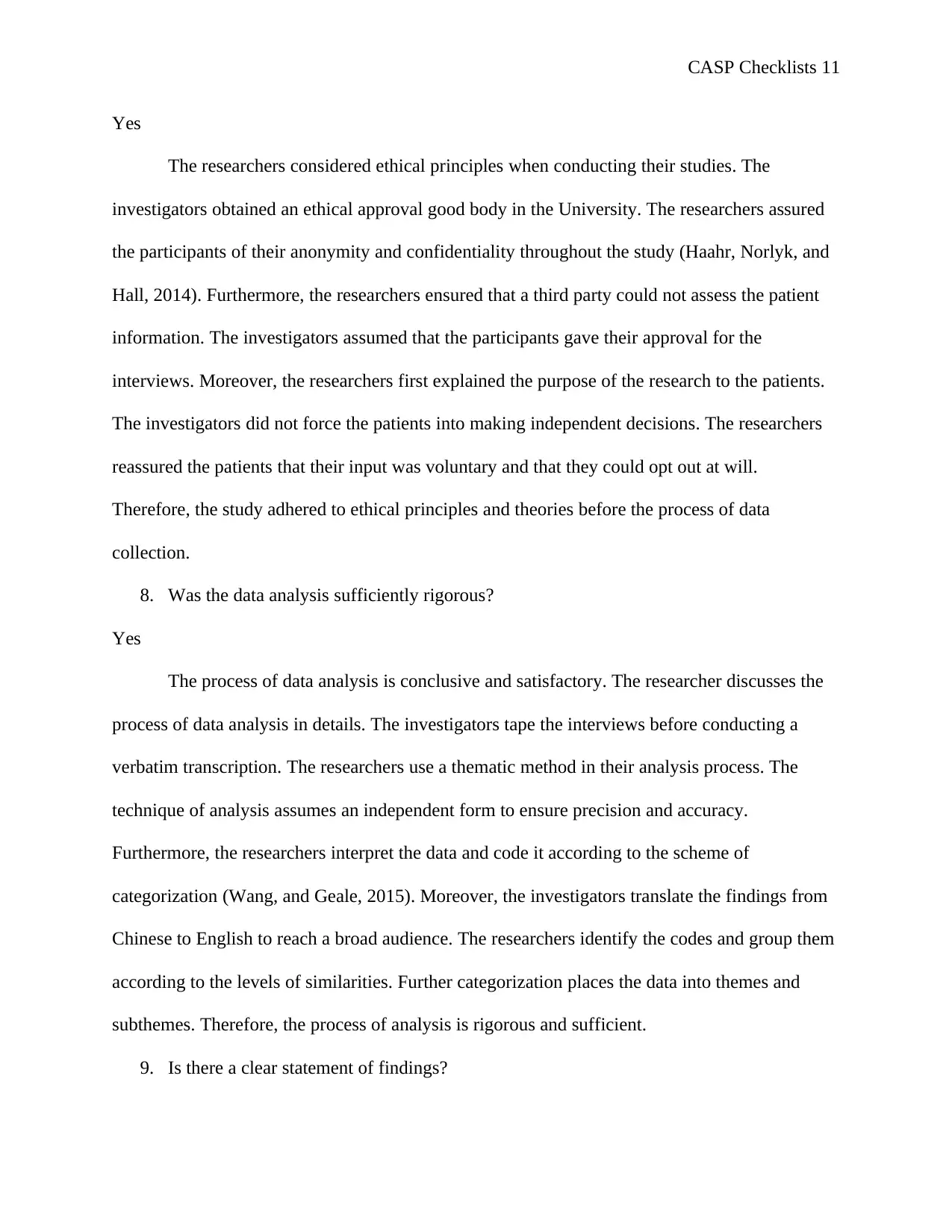
CASP Checklists 11
Yes
The researchers considered ethical principles when conducting their studies. The
investigators obtained an ethical approval good body in the University. The researchers assured
the participants of their anonymity and confidentiality throughout the study (Haahr, Norlyk, and
Hall, 2014). Furthermore, the researchers ensured that a third party could not assess the patient
information. The investigators assumed that the participants gave their approval for the
interviews. Moreover, the researchers first explained the purpose of the research to the patients.
The investigators did not force the patients into making independent decisions. The researchers
reassured the patients that their input was voluntary and that they could opt out at will.
Therefore, the study adhered to ethical principles and theories before the process of data
collection.
8. Was the data analysis sufficiently rigorous?
Yes
The process of data analysis is conclusive and satisfactory. The researcher discusses the
process of data analysis in details. The investigators tape the interviews before conducting a
verbatim transcription. The researchers use a thematic method in their analysis process. The
technique of analysis assumes an independent form to ensure precision and accuracy.
Furthermore, the researchers interpret the data and code it according to the scheme of
categorization (Wang, and Geale, 2015). Moreover, the investigators translate the findings from
Chinese to English to reach a broad audience. The researchers identify the codes and group them
according to the levels of similarities. Further categorization places the data into themes and
subthemes. Therefore, the process of analysis is rigorous and sufficient.
9. Is there a clear statement of findings?
Yes
The researchers considered ethical principles when conducting their studies. The
investigators obtained an ethical approval good body in the University. The researchers assured
the participants of their anonymity and confidentiality throughout the study (Haahr, Norlyk, and
Hall, 2014). Furthermore, the researchers ensured that a third party could not assess the patient
information. The investigators assumed that the participants gave their approval for the
interviews. Moreover, the researchers first explained the purpose of the research to the patients.
The investigators did not force the patients into making independent decisions. The researchers
reassured the patients that their input was voluntary and that they could opt out at will.
Therefore, the study adhered to ethical principles and theories before the process of data
collection.
8. Was the data analysis sufficiently rigorous?
Yes
The process of data analysis is conclusive and satisfactory. The researcher discusses the
process of data analysis in details. The investigators tape the interviews before conducting a
verbatim transcription. The researchers use a thematic method in their analysis process. The
technique of analysis assumes an independent form to ensure precision and accuracy.
Furthermore, the researchers interpret the data and code it according to the scheme of
categorization (Wang, and Geale, 2015). Moreover, the investigators translate the findings from
Chinese to English to reach a broad audience. The researchers identify the codes and group them
according to the levels of similarities. Further categorization places the data into themes and
subthemes. Therefore, the process of analysis is rigorous and sufficient.
9. Is there a clear statement of findings?
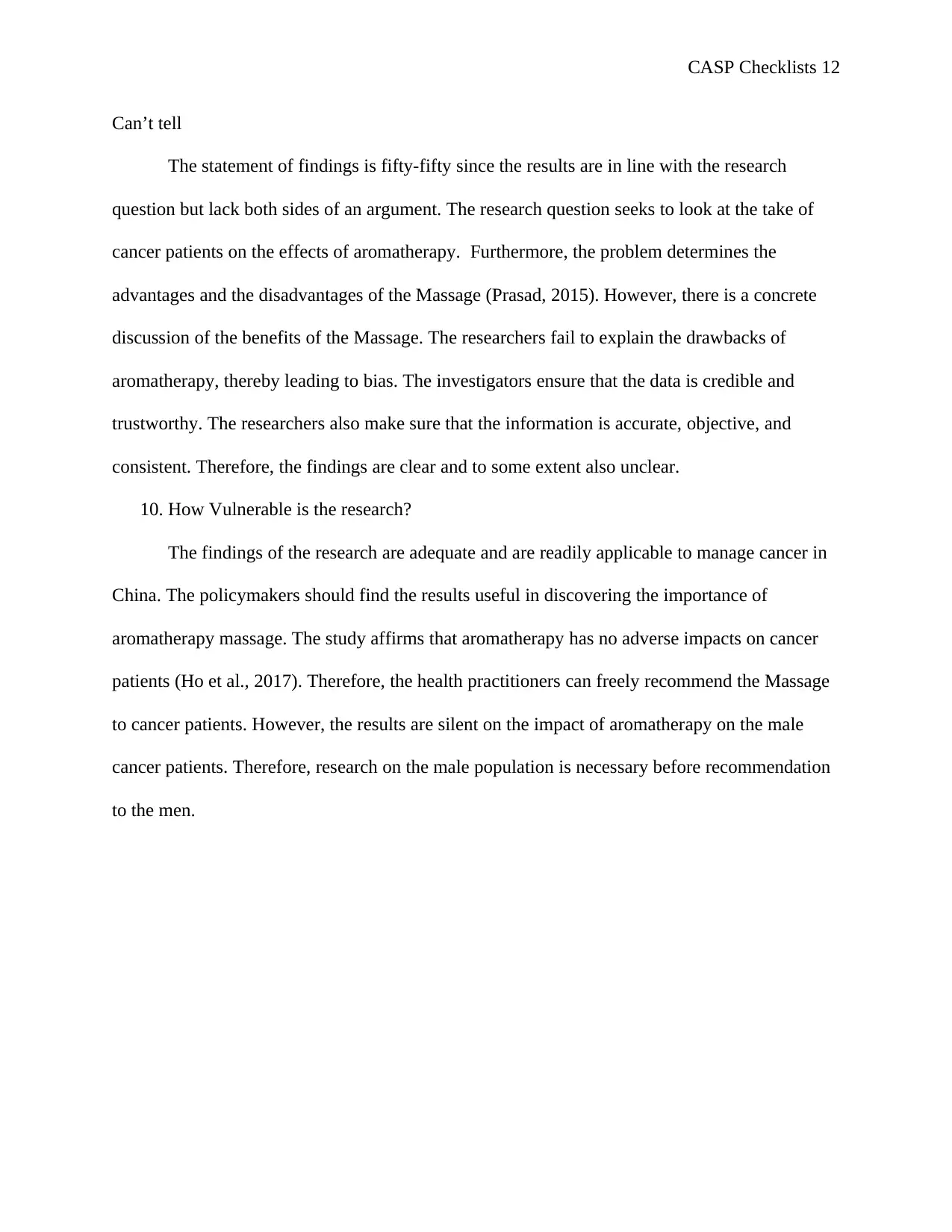
CASP Checklists 12
Can’t tell
The statement of findings is fifty-fifty since the results are in line with the research
question but lack both sides of an argument. The research question seeks to look at the take of
cancer patients on the effects of aromatherapy. Furthermore, the problem determines the
advantages and the disadvantages of the Massage (Prasad, 2015). However, there is a concrete
discussion of the benefits of the Massage. The researchers fail to explain the drawbacks of
aromatherapy, thereby leading to bias. The investigators ensure that the data is credible and
trustworthy. The researchers also make sure that the information is accurate, objective, and
consistent. Therefore, the findings are clear and to some extent also unclear.
10. How Vulnerable is the research?
The findings of the research are adequate and are readily applicable to manage cancer in
China. The policymakers should find the results useful in discovering the importance of
aromatherapy massage. The study affirms that aromatherapy has no adverse impacts on cancer
patients (Ho et al., 2017). Therefore, the health practitioners can freely recommend the Massage
to cancer patients. However, the results are silent on the impact of aromatherapy on the male
cancer patients. Therefore, research on the male population is necessary before recommendation
to the men.
Can’t tell
The statement of findings is fifty-fifty since the results are in line with the research
question but lack both sides of an argument. The research question seeks to look at the take of
cancer patients on the effects of aromatherapy. Furthermore, the problem determines the
advantages and the disadvantages of the Massage (Prasad, 2015). However, there is a concrete
discussion of the benefits of the Massage. The researchers fail to explain the drawbacks of
aromatherapy, thereby leading to bias. The investigators ensure that the data is credible and
trustworthy. The researchers also make sure that the information is accurate, objective, and
consistent. Therefore, the findings are clear and to some extent also unclear.
10. How Vulnerable is the research?
The findings of the research are adequate and are readily applicable to manage cancer in
China. The policymakers should find the results useful in discovering the importance of
aromatherapy massage. The study affirms that aromatherapy has no adverse impacts on cancer
patients (Ho et al., 2017). Therefore, the health practitioners can freely recommend the Massage
to cancer patients. However, the results are silent on the impact of aromatherapy on the male
cancer patients. Therefore, research on the male population is necessary before recommendation
to the men.
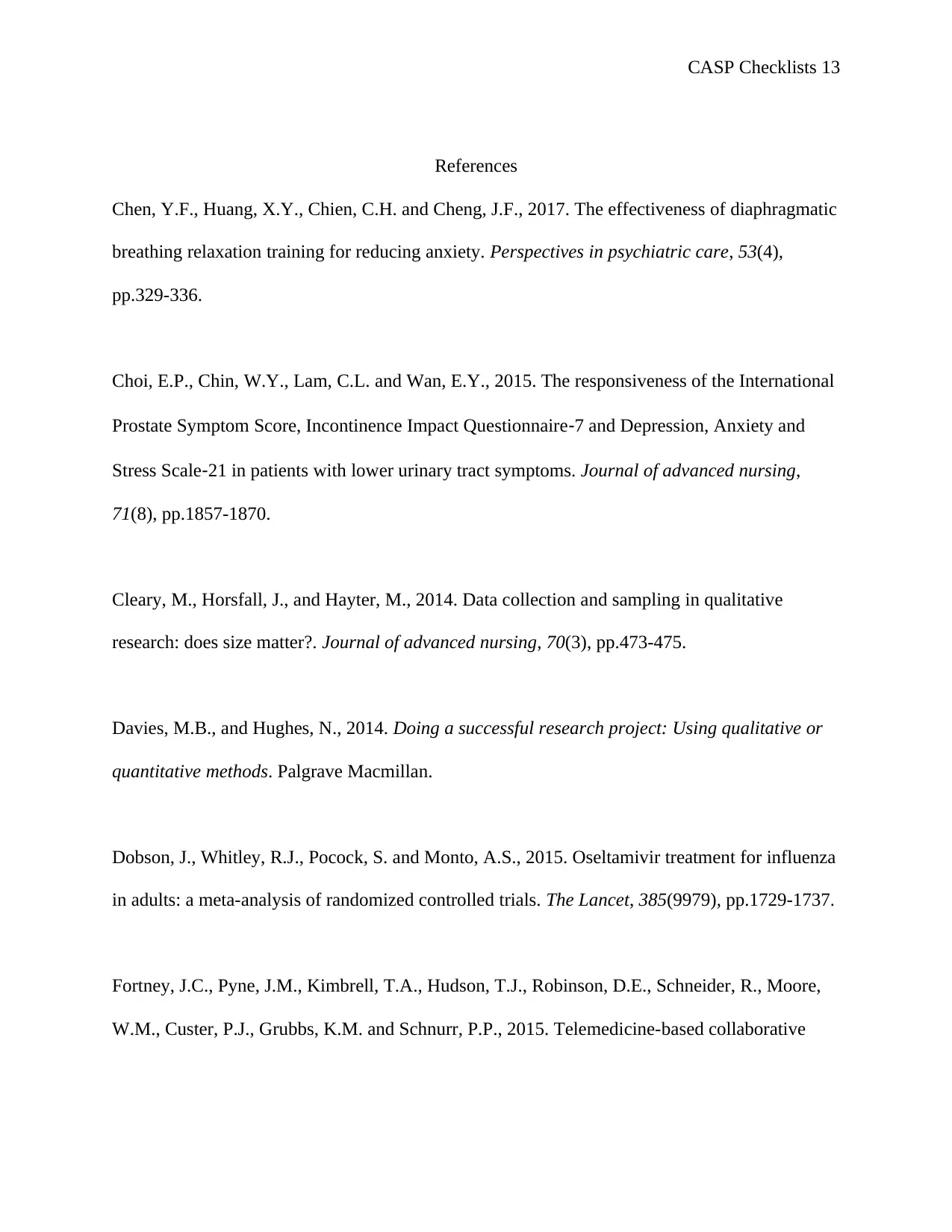
CASP Checklists 13
References
Chen, Y.F., Huang, X.Y., Chien, C.H. and Cheng, J.F., 2017. The effectiveness of diaphragmatic
breathing relaxation training for reducing anxiety. Perspectives in psychiatric care, 53(4),
pp.329-336.
Choi, E.P., Chin, W.Y., Lam, C.L. and Wan, E.Y., 2015. The responsiveness of the International
Prostate Symptom Score, Incontinence Impact Questionnaire‐7 and Depression, Anxiety and
Stress Scale‐21 in patients with lower urinary tract symptoms. Journal of advanced nursing,
71(8), pp.1857-1870.
Cleary, M., Horsfall, J., and Hayter, M., 2014. Data collection and sampling in qualitative
research: does size matter?. Journal of advanced nursing, 70(3), pp.473-475.
Davies, M.B., and Hughes, N., 2014. Doing a successful research project: Using qualitative or
quantitative methods. Palgrave Macmillan.
Dobson, J., Whitley, R.J., Pocock, S. and Monto, A.S., 2015. Oseltamivir treatment for influenza
in adults: a meta-analysis of randomized controlled trials. The Lancet, 385(9979), pp.1729-1737.
Fortney, J.C., Pyne, J.M., Kimbrell, T.A., Hudson, T.J., Robinson, D.E., Schneider, R., Moore,
W.M., Custer, P.J., Grubbs, K.M. and Schnurr, P.P., 2015. Telemedicine-based collaborative
References
Chen, Y.F., Huang, X.Y., Chien, C.H. and Cheng, J.F., 2017. The effectiveness of diaphragmatic
breathing relaxation training for reducing anxiety. Perspectives in psychiatric care, 53(4),
pp.329-336.
Choi, E.P., Chin, W.Y., Lam, C.L. and Wan, E.Y., 2015. The responsiveness of the International
Prostate Symptom Score, Incontinence Impact Questionnaire‐7 and Depression, Anxiety and
Stress Scale‐21 in patients with lower urinary tract symptoms. Journal of advanced nursing,
71(8), pp.1857-1870.
Cleary, M., Horsfall, J., and Hayter, M., 2014. Data collection and sampling in qualitative
research: does size matter?. Journal of advanced nursing, 70(3), pp.473-475.
Davies, M.B., and Hughes, N., 2014. Doing a successful research project: Using qualitative or
quantitative methods. Palgrave Macmillan.
Dobson, J., Whitley, R.J., Pocock, S. and Monto, A.S., 2015. Oseltamivir treatment for influenza
in adults: a meta-analysis of randomized controlled trials. The Lancet, 385(9979), pp.1729-1737.
Fortney, J.C., Pyne, J.M., Kimbrell, T.A., Hudson, T.J., Robinson, D.E., Schneider, R., Moore,
W.M., Custer, P.J., Grubbs, K.M. and Schnurr, P.P., 2015. Telemedicine-based collaborative
Paraphrase This Document
Need a fresh take? Get an instant paraphrase of this document with our AI Paraphraser
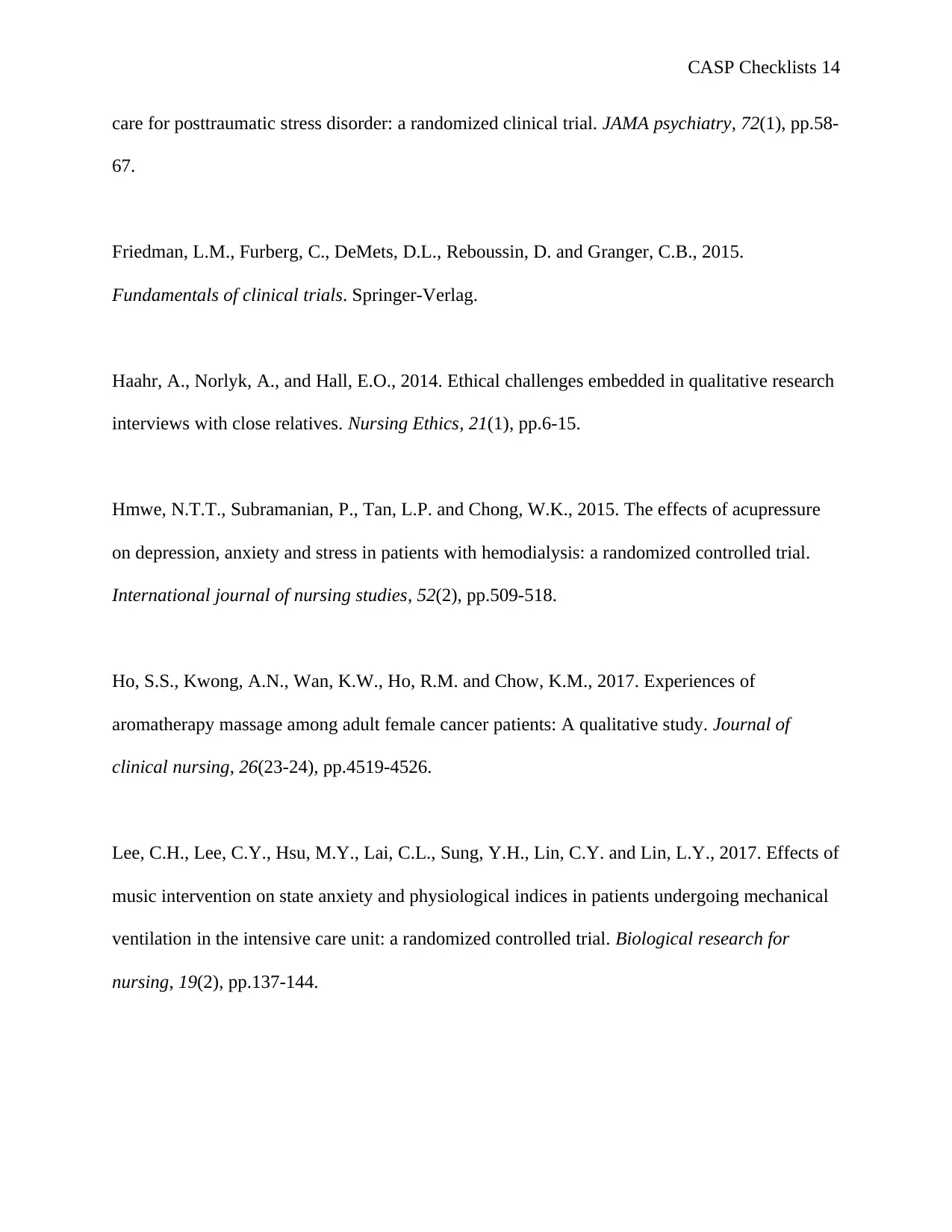
CASP Checklists 14
care for posttraumatic stress disorder: a randomized clinical trial. JAMA psychiatry, 72(1), pp.58-
67.
Friedman, L.M., Furberg, C., DeMets, D.L., Reboussin, D. and Granger, C.B., 2015.
Fundamentals of clinical trials. Springer-Verlag.
Haahr, A., Norlyk, A., and Hall, E.O., 2014. Ethical challenges embedded in qualitative research
interviews with close relatives. Nursing Ethics, 21(1), pp.6-15.
Hmwe, N.T.T., Subramanian, P., Tan, L.P. and Chong, W.K., 2015. The effects of acupressure
on depression, anxiety and stress in patients with hemodialysis: a randomized controlled trial.
International journal of nursing studies, 52(2), pp.509-518.
Ho, S.S., Kwong, A.N., Wan, K.W., Ho, R.M. and Chow, K.M., 2017. Experiences of
aromatherapy massage among adult female cancer patients: A qualitative study. Journal of
clinical nursing, 26(23-24), pp.4519-4526.
Lee, C.H., Lee, C.Y., Hsu, M.Y., Lai, C.L., Sung, Y.H., Lin, C.Y. and Lin, L.Y., 2017. Effects of
music intervention on state anxiety and physiological indices in patients undergoing mechanical
ventilation in the intensive care unit: a randomized controlled trial. Biological research for
nursing, 19(2), pp.137-144.
care for posttraumatic stress disorder: a randomized clinical trial. JAMA psychiatry, 72(1), pp.58-
67.
Friedman, L.M., Furberg, C., DeMets, D.L., Reboussin, D. and Granger, C.B., 2015.
Fundamentals of clinical trials. Springer-Verlag.
Haahr, A., Norlyk, A., and Hall, E.O., 2014. Ethical challenges embedded in qualitative research
interviews with close relatives. Nursing Ethics, 21(1), pp.6-15.
Hmwe, N.T.T., Subramanian, P., Tan, L.P. and Chong, W.K., 2015. The effects of acupressure
on depression, anxiety and stress in patients with hemodialysis: a randomized controlled trial.
International journal of nursing studies, 52(2), pp.509-518.
Ho, S.S., Kwong, A.N., Wan, K.W., Ho, R.M. and Chow, K.M., 2017. Experiences of
aromatherapy massage among adult female cancer patients: A qualitative study. Journal of
clinical nursing, 26(23-24), pp.4519-4526.
Lee, C.H., Lee, C.Y., Hsu, M.Y., Lai, C.L., Sung, Y.H., Lin, C.Y. and Lin, L.Y., 2017. Effects of
music intervention on state anxiety and physiological indices in patients undergoing mechanical
ventilation in the intensive care unit: a randomized controlled trial. Biological research for
nursing, 19(2), pp.137-144.
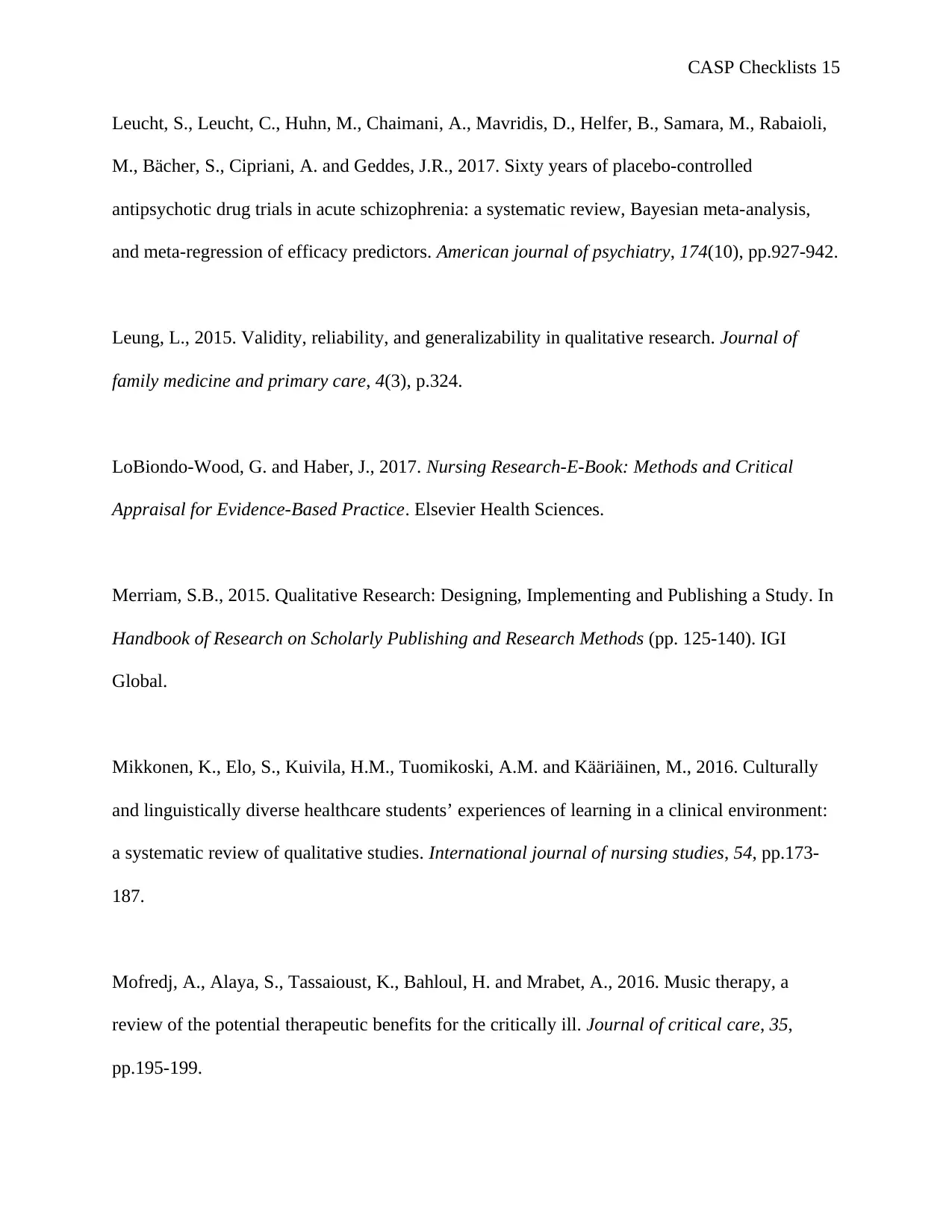
CASP Checklists 15
Leucht, S., Leucht, C., Huhn, M., Chaimani, A., Mavridis, D., Helfer, B., Samara, M., Rabaioli,
M., Bächer, S., Cipriani, A. and Geddes, J.R., 2017. Sixty years of placebo-controlled
antipsychotic drug trials in acute schizophrenia: a systematic review, Bayesian meta-analysis,
and meta-regression of efficacy predictors. American journal of psychiatry, 174(10), pp.927-942.
Leung, L., 2015. Validity, reliability, and generalizability in qualitative research. Journal of
family medicine and primary care, 4(3), p.324.
LoBiondo-Wood, G. and Haber, J., 2017. Nursing Research-E-Book: Methods and Critical
Appraisal for Evidence-Based Practice. Elsevier Health Sciences.
Merriam, S.B., 2015. Qualitative Research: Designing, Implementing and Publishing a Study. In
Handbook of Research on Scholarly Publishing and Research Methods (pp. 125-140). IGI
Global.
Mikkonen, K., Elo, S., Kuivila, H.M., Tuomikoski, A.M. and Kääriäinen, M., 2016. Culturally
and linguistically diverse healthcare students’ experiences of learning in a clinical environment:
a systematic review of qualitative studies. International journal of nursing studies, 54, pp.173-
187.
Mofredj, A., Alaya, S., Tassaioust, K., Bahloul, H. and Mrabet, A., 2016. Music therapy, a
review of the potential therapeutic benefits for the critically ill. Journal of critical care, 35,
pp.195-199.
Leucht, S., Leucht, C., Huhn, M., Chaimani, A., Mavridis, D., Helfer, B., Samara, M., Rabaioli,
M., Bächer, S., Cipriani, A. and Geddes, J.R., 2017. Sixty years of placebo-controlled
antipsychotic drug trials in acute schizophrenia: a systematic review, Bayesian meta-analysis,
and meta-regression of efficacy predictors. American journal of psychiatry, 174(10), pp.927-942.
Leung, L., 2015. Validity, reliability, and generalizability in qualitative research. Journal of
family medicine and primary care, 4(3), p.324.
LoBiondo-Wood, G. and Haber, J., 2017. Nursing Research-E-Book: Methods and Critical
Appraisal for Evidence-Based Practice. Elsevier Health Sciences.
Merriam, S.B., 2015. Qualitative Research: Designing, Implementing and Publishing a Study. In
Handbook of Research on Scholarly Publishing and Research Methods (pp. 125-140). IGI
Global.
Mikkonen, K., Elo, S., Kuivila, H.M., Tuomikoski, A.M. and Kääriäinen, M., 2016. Culturally
and linguistically diverse healthcare students’ experiences of learning in a clinical environment:
a systematic review of qualitative studies. International journal of nursing studies, 54, pp.173-
187.
Mofredj, A., Alaya, S., Tassaioust, K., Bahloul, H. and Mrabet, A., 2016. Music therapy, a
review of the potential therapeutic benefits for the critically ill. Journal of critical care, 35,
pp.195-199.
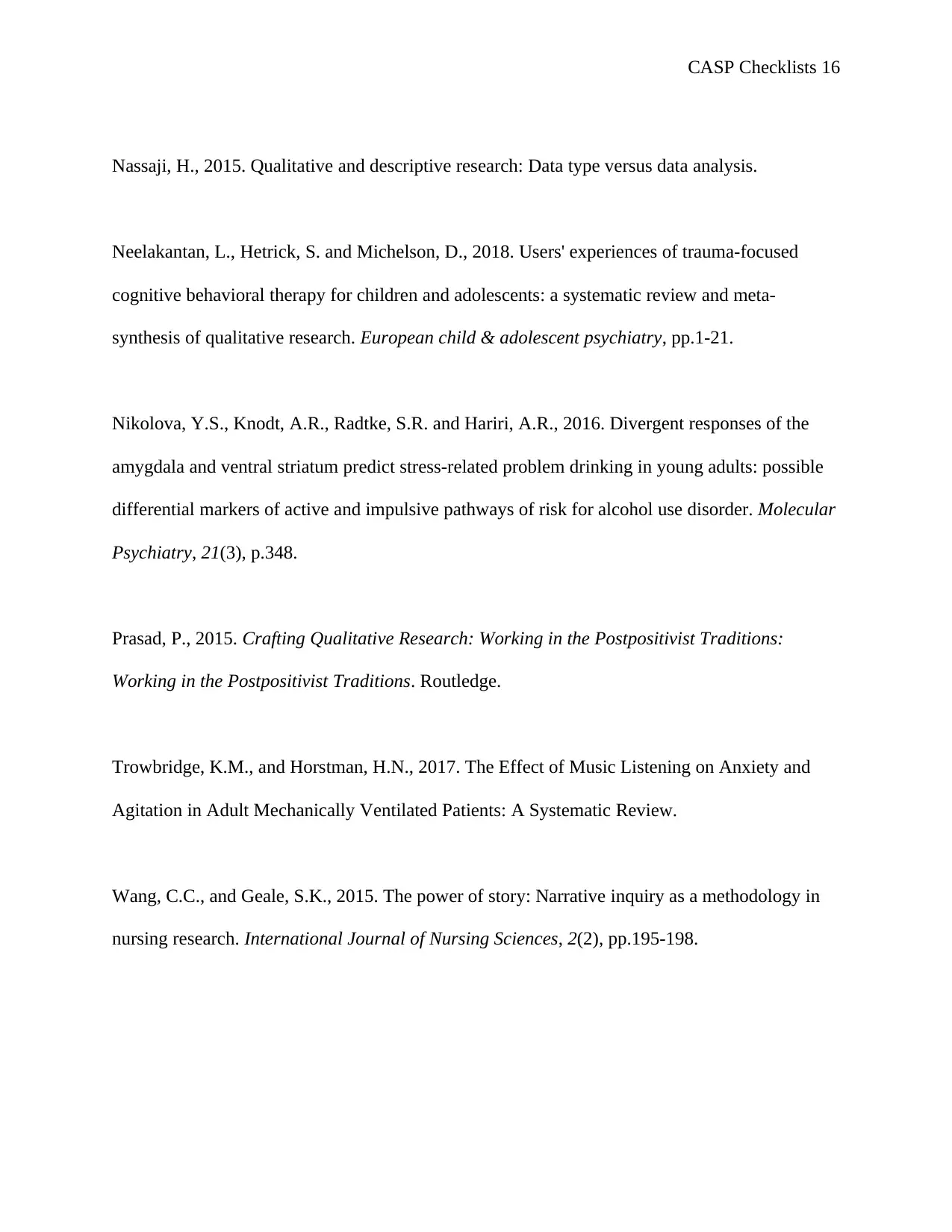
CASP Checklists 16
Nassaji, H., 2015. Qualitative and descriptive research: Data type versus data analysis.
Neelakantan, L., Hetrick, S. and Michelson, D., 2018. Users' experiences of trauma-focused
cognitive behavioral therapy for children and adolescents: a systematic review and meta-
synthesis of qualitative research. European child & adolescent psychiatry, pp.1-21.
Nikolova, Y.S., Knodt, A.R., Radtke, S.R. and Hariri, A.R., 2016. Divergent responses of the
amygdala and ventral striatum predict stress-related problem drinking in young adults: possible
differential markers of active and impulsive pathways of risk for alcohol use disorder. Molecular
Psychiatry, 21(3), p.348.
Prasad, P., 2015. Crafting Qualitative Research: Working in the Postpositivist Traditions:
Working in the Postpositivist Traditions. Routledge.
Trowbridge, K.M., and Horstman, H.N., 2017. The Effect of Music Listening on Anxiety and
Agitation in Adult Mechanically Ventilated Patients: A Systematic Review.
Wang, C.C., and Geale, S.K., 2015. The power of story: Narrative inquiry as a methodology in
nursing research. International Journal of Nursing Sciences, 2(2), pp.195-198.
Nassaji, H., 2015. Qualitative and descriptive research: Data type versus data analysis.
Neelakantan, L., Hetrick, S. and Michelson, D., 2018. Users' experiences of trauma-focused
cognitive behavioral therapy for children and adolescents: a systematic review and meta-
synthesis of qualitative research. European child & adolescent psychiatry, pp.1-21.
Nikolova, Y.S., Knodt, A.R., Radtke, S.R. and Hariri, A.R., 2016. Divergent responses of the
amygdala and ventral striatum predict stress-related problem drinking in young adults: possible
differential markers of active and impulsive pathways of risk for alcohol use disorder. Molecular
Psychiatry, 21(3), p.348.
Prasad, P., 2015. Crafting Qualitative Research: Working in the Postpositivist Traditions:
Working in the Postpositivist Traditions. Routledge.
Trowbridge, K.M., and Horstman, H.N., 2017. The Effect of Music Listening on Anxiety and
Agitation in Adult Mechanically Ventilated Patients: A Systematic Review.
Wang, C.C., and Geale, S.K., 2015. The power of story: Narrative inquiry as a methodology in
nursing research. International Journal of Nursing Sciences, 2(2), pp.195-198.
Secure Best Marks with AI Grader
Need help grading? Try our AI Grader for instant feedback on your assignments.
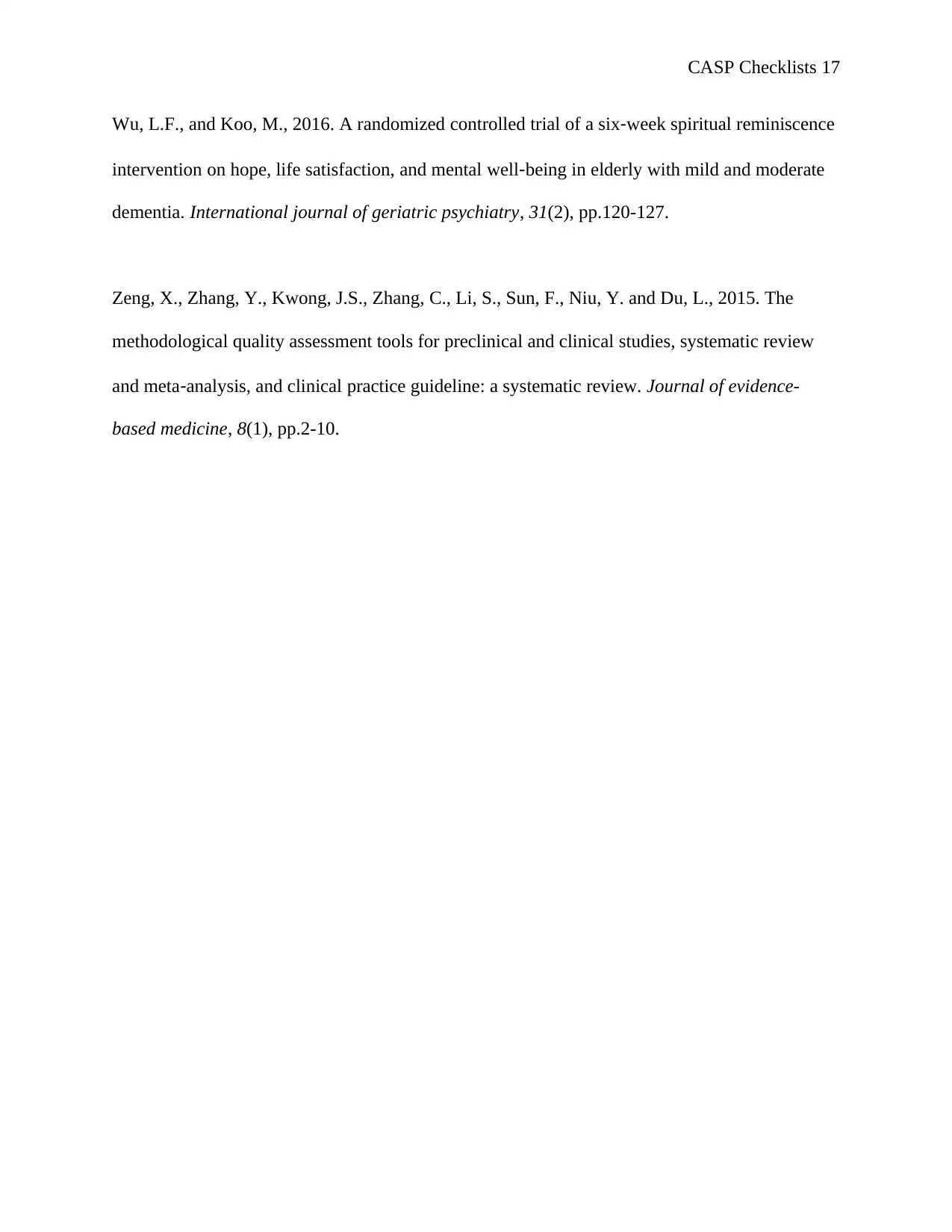
CASP Checklists 17
Wu, L.F., and Koo, M., 2016. A randomized controlled trial of a six‐week spiritual reminiscence
intervention on hope, life satisfaction, and mental well‐being in elderly with mild and moderate
dementia. International journal of geriatric psychiatry, 31(2), pp.120-127.
Zeng, X., Zhang, Y., Kwong, J.S., Zhang, C., Li, S., Sun, F., Niu, Y. and Du, L., 2015. The
methodological quality assessment tools for preclinical and clinical studies, systematic review
and meta‐analysis, and clinical practice guideline: a systematic review. Journal of evidence-
based medicine, 8(1), pp.2-10.
Wu, L.F., and Koo, M., 2016. A randomized controlled trial of a six‐week spiritual reminiscence
intervention on hope, life satisfaction, and mental well‐being in elderly with mild and moderate
dementia. International journal of geriatric psychiatry, 31(2), pp.120-127.
Zeng, X., Zhang, Y., Kwong, J.S., Zhang, C., Li, S., Sun, F., Niu, Y. and Du, L., 2015. The
methodological quality assessment tools for preclinical and clinical studies, systematic review
and meta‐analysis, and clinical practice guideline: a systematic review. Journal of evidence-
based medicine, 8(1), pp.2-10.
1 out of 17
Related Documents
Your All-in-One AI-Powered Toolkit for Academic Success.
+13062052269
info@desklib.com
Available 24*7 on WhatsApp / Email
![[object Object]](/_next/static/media/star-bottom.7253800d.svg)
Unlock your academic potential
© 2024 | Zucol Services PVT LTD | All rights reserved.





